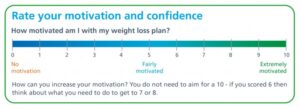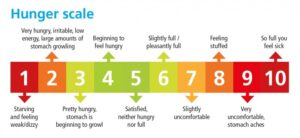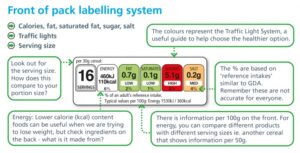Information and tips on weight loss
The sections below contain a range of useful links and resources.
Note: If you feel you need support to make sustainable diet and lifestyle changes to improve your health, please speak to your doctor or GP.
What do I want to work on?
What do I want to work on?
Being specific about areas that you want to focus on is important in creating a good plan that will help you with your goals.
Which of these are true for you?
Physical activity
- I set myself goals for how active I’ll be each day or week.
- I follow an exercise plan/routine.
- When I’m being active, I push myself to my limits.
- I keep track of the physical activity that I do.
Controlling cravings and mindfulness
- If I feel like eating but am trying not to, I pause and ask myself if I’m hungry.
- If I feel like eating but am trying not to, I make myself wait a certain amount of time to see if the craving passes.
- I use smaller plates and bowls when eating to help with my portion control.
- I slow down how quickly I eat in an effort to eat less.
Support and wellbeing
- I acknowledge negative emotions and can speak to somebody, use technology or specific techniques (for example, meditation) to help with these.
- I’ve tried to get my friends and family to support me in managing my weight.
- I belong to a group of people who are trying to lose weight together (for example, an online discussion forum).
- I use a weight loss service to help manage my weight (for example, Weight Watchers, Slimming World, Lighter Life).
Meal and grocery planning
- When I’m grocery shopping and items of food look similar, I make my choice based on the nutritional information on the food labels.
- I plan my food shopping in advance to help me stick to my plan (for example, use a shopping list).
- To avoid eating and drinking things that don’t fit with my plan, I don’t keep them at home.
- When I am food shopping, there are certain foods I stay away from to help me stick to my plan.
Weight loss planning and monitoring
- I use a chart, diary or app to track my progress in losing weight.
- I use a book, website, or app to look up the nutritional information and (or) calorie content of the foods I eat.
- I check the portion sizes of the things I eat.
- I have a weight management plan, but I allow myself to be flexible about what I do depending on circumstances.
Adapted from OxFAB Taxonomy and questionnaire: Hartmann-Boyce et al., (2016). Development of tools to study personal weight control strategies: OxFAB taxonomy. Obesity, 24(2), pp. 314–320
Physical activity
Physical activity
Tips for making it easier to be active in your home
Getting your home environment ready for activity will make it easier for you to do activity every day.
- Do your activity at the same time each day. Think about the other people in your house and choose a time that is the easiest for you to fit in.
- Start small and build up. If every day is unrealistic, start with 2 or 3 times a week.
- Tell other people in your house your plan. Either ask them to join in or stay out of the way.
- If you have space in your home, you can make an area that is specifically for your activity.
- If you live alone, tell friends or family so they do not call you during this time.
- Write ‘activity’ on your calendar or in your phone, as a daily reminder.
- Find clothes that are comfortable to be active in and get them ready, for example, if your activity is in the morning, get your clothes out the night before.
- Celebrate every time you complete an activity! Whatever you have done is better than nothing, so congratulate yourself. Think of the positive things you would say to a friend who had just done this, now say them to yourself.
- Think about your common reasons for not doing activity and how you can avoid this ‘danger zone’. For example:
| Danger zone | Planned action |
| I want to do my activity after I have finished my working day, but I am always too hungry. | I will have a snack (fruit, crackers) one hour before my working day finishes. |
| I am stressed and don’t think I have the energy to do my activity today. | I will remind myself that exercise will help to reduce stress and improve my mood. |
| I have been invited to a zoom call during my scheduled activity. | I will get changed into my exercise clothes and call my friends after I have done my activity. |
References
Fogg, B.J. (2019) Tiny Habits. London: Virgin Books.
Otto, M. & Smits, J (2011). Exercise for Mood and Anxiety: Proven Strategies for Overcoming Depression and Enhancing Well-bring. Oxford University Press.
Pilling, S & Newman, R (2012). Braintree self help guide. London: London Strategic Health Authority.
Recommended equipment
- Resistance bands: Choose multi-level bands with handles (suitable for everyone and can be bought online).
- Weighing scales: Choose digital ones to easily track any weight changes (can be bought online or from big supermarkets).
Intermediate home exercises
Note: Numbers 1 to 5 are for warming up. Numbers 6, 15 to 19 can be done with shopping bags filled with water bottles (1L equals 1KG), or tins around the house. Search YouTube for Home exercise videos. Anything that gets your heart rate up to 120bpm will be effective.
Resources for adults
- Exercise video for people who are new to exercise or do not exercise very much, can be done standing or seated
- Exercise video for people who exercise regularly using items from around the house (tins of beans, bags of flour)
- 10 minute workout videos for people who exercise regularly, that do not require equipment
- 23 and ½ hours: What is the single best thing we can do for our health?
- NHS exercise guidelines and workouts
- Free 9 week exercise programme for all levels
Exercise with children and young people
Controlling cravings and mindfulness
Controlling cravings and mindfulness
What is mindfulness?
“The awareness that arises from paying attention, on purpose, in the present moment and non-judgmentally.” Jon Kabat-Zinn
What is mindful eating?
“Using all your senses in choosing to eat food that is both satisfying to you and nourishing to your body… Becoming aware of physical hunger and satiety cues to guide your decisions to begin and end eating.” Megrette Fletcher
Benefits of mindful eating
- Helps develop a better relationship with food and body image.
- Has been shown to help with weight loss and improve food choices.
- No strict rules, no cost and can be simple to practice.
- Can help reduce stress and anxiety levels.
Mindful breathing
Try this technique on a regular basis, when you have cravings or during times of stress.
- Sit comfortably but upright and close your eyes.
- Focus on your breathing without changing it. Observe the feeling in the nose, rise and fall of chest, etc.
- Thoughts will arise. Notice these but do not fight or ‘feed’ them.
- Bring the attention back to the breath. Don’t worry if you are bringing your attention back many times, this is the practice.
- Start with a 5 minute practice and increase gradually. Setting a timer is helpful to prevent checking the time during the practice.
Top tips
- Use the hunger scale to rate your hunger before, halfway through, immediately after, and 20 minutes after eating.
- Create a pleasant eating environment and try to minimise distractions.
- Slow down your pace of eating by chewing more and putting your knife and fork down at regular intervals.
- Use smaller sized plates and bowls.
- Focus on the present moment whilst eating: the smell of the food, texture and the tastes. Notice how all these things change moment by moment.
- When you have a craving, try the mindful breathing exercise above and allow at least 30 minutes to see if the craving reduces.
Resources
Support and wellbeing
Support and wellbeing
Tips on how to make a daily schedule
Making a schedule might seem like a difficult task, but it will make it easier to organise your daily life. A routine can help to break up the day, support mental wellbeing and promote healthier eating and physical activity habits. If you live with other people consider making a schedule together.
- Try to go to bed and get up at the same time. You may want to lie in, especially if you do not need to get up for work, but doing this on a regular basis can disrupt your sleep.
- Get dressed for the day, even if you’re not going anywhere.
- Set yourself small goals that are easily achieved and celebrate when you are successful at these.
In your schedule, include:
- When you will eat, go shopping, and plan meals.
- When you will do your physical activity, for example, going for a walk or an exercise routine at home.
- When you will work (if you are working), try to stick to your normal work times.
- When you will do your chores and household jobs.
- When you will do something that is good for your mental wellbeing for example, speaking to friends and family on the telephone, reading, doing a jigsaw, watching a film.
- If you can, find some space where you can work if you are working from home, make it your ‘office or place for work’.
- Try to get some fresh air every day, even if it’s just a walk around the garden.
- Be flexible. The schedule is a guide, it is ok go with the flow sometimes.
- If you are spending a lot of time at home, you may find it helpful to keep things clean and tidy.
References
UNICEF (2020) How to organize time in home quarantine. [Online] Serbia: UNICEF. Available from: How to organize time in home quarantine | UNICEF Serbia [Accessed 30.04.2020].
Mind (2020) Coronavirus and your wellbeing. [Online] Mind. Available from: Coronavirus: Looking after your mental wellbeing and mind, the mental health charity, help for mental health problems[Accessed 01 May 2020].
NHS (2019) How to get to sleep. [Online] NHS. Available from: How to get to sleep (NHS) [Accessed 01 May 2020].
Reflecting on how you feel
- Take time to think about your feelings and emotions. Writing these down may help.
- Are these positive, negative or neutral?
- How often do you feel negative emotions and are there common triggers?
- When do you feel more positive and what helps with this?
- How does your mood affect your weight loss plan?
- How many hours do you sleep and is it disturbed, light or deep?

Getting the support you need
Who can support me?
- Friends and family- speak to them about your goals. What can they do to help you?
- Online weight loss groups and forums.
- Speak with your GP.
- See the links on our website under Support and Wellbeing.
- Weight loss apps and websites.
- NHS Mental Health and Wellbeing website for tips on reducing stress, anxiety and improving sleep.
Resources for adults
Meal planning
Meal planning
Traffic light system
Look out for the food products with green, amber or red coloured labels on the front of the pack. At a glance, they show you if the product has low, medium or high amounts of fat, saturated fat, sugars and salt, helping you make a better choice.
Red: It’s fine to have this food occasionally, but think about how often you choose it and how much of it you eat.
Amber: A better option than red and it is fine to have this in moderation. This would be an ok choice.
Green: This means a healthier choice.
Front of pack labelling system
- Calories, fat, saturated fat, sugar, salt
- Traffic lights
- Serving size
- Look out for the serving size. How does this compare to your portion size?
- The colours represent the traffic light system, a useful guide to help choose the healthier option.
- The percentages are based on ‘reference intakes’ similar to GDA. Remember these are not accurate for everyone.
- Energy: Lower calorie (kcal) content foods can be useful when we are trying to lose weight, but check ingredients on the back, what is it made from?
- There is information per 100g on the back. Checking this is a helpful way to compare different products.
Top tips
- Plan your main meals and snacks for the week ahead. It may help to put this up somewhere visible, for example, on the fridge.
- Before you go shopping, make a list using your weekly meal plan. This will help to reduce impulse buys.
- Use food labels to make healthier choices when in the supermarket.
- If you cook and shop with other people in the house, try to create the meal plan and shopping list together.
- If other people in the house have higher calorie snacks or you have these as occasional treats then put somewhere not easily visible, for example, back of the cupboard.
Resources
Weight management planning
Weight management planning
What determines my body weight?
There is a pre-set weight at which your body will work best. This is the weight your body naturally returns to after short-term under or overeating or exercising.
This does not always fit into the healthy Body Mass Index (BMI) range that many health professionals talk about.
If your weight has been increasing for a long time, your body may forget what your natural pre-set weight is and keep returning to your higher weight. This can make it hard to lose weight and keep it off.
How can I change my weight?
The longer you have been a certain weight, the more difficult it is to ‘re-set’ your body to its natural weight. The good news is it can still be done!
It requires a lot of will power and effort. Usually, you must remain at your new weight for 6 to 12 months before your body agrees that it is your natural weight.
Being able to stay on track and keep motivated in the long term is really important in your journey to success.
How are your new healthy changes going?
Record a healthy change you are achieving:
- What is going well? For example, getting up 5 minutes earlier is no problem and I can manage it everyday.
- A healthy change you are finding difficult, for example doing everyday activity.
- What is holding you back? For example, I have fallen out of the habit.
Date |
Weight |
Goal |
|---|---|---|
Top tips
- Create a sensible long-term goal, for example, between 5 and 10% weight loss in 6 months.
- Weigh yourself weekly or fortnightly.
- Track your weight changes by making a graph, use an app, or simply write down your weight in the table above.
- Write down your weight loss plan, make it specific and put it up somewhere you can see, for example, on the fridge.
- Recognise and celebrate positive changes made.
Weighing scales
Below is a list of weighing scales that are available to buy for your own use at home.
Please note, none of the models listed below are specifically endorsed by our service.
Before you make a purchase, we would recommend you:
- read reviews of a product before you buy it
- choose digital scales if possible
- consider how heavy it is (in case you want to move it)
- consider how low to the ground it is (for ease of stepping onto them)
- consider whether the company offer a refund or guarantee
- consider whether it comes with batteries
Capacity: up to 180kg |
|
|---|---|
| Electronic Body Scales (White) | maximum weight 180kg (Wilko): £9.99 |
| Bathroom Scales (Silver) | maximum weight 180kg (Salter, Argos): £17.00 |
| Glass Digital Bathroom Scale (Clear) | maximum weight 180kg (Salter): £22.99 |
| HomeFashion Digital Bathroom Scale | maximum weight 180kg (HomeFashion, Amazon): £8.99 |
Capacity (up to 250kg) |
|
|---|---|
| Vitafit 250kg Digital Bathroom Scales for Body Weight and BMI Via Smart APP | maximum weight 250kg (Vitafit, Amazon): £21.99 |
| Max Digital Bathroom Scale (Black) | maximum weight 250kg (Salter): £29.99 |
| RENPHO Weighing Scales | maximum weight 250kg (RENPHO, Amazon): £26.99 |
Resources
LCH specialist weight management physical activity resource
LCH specialist weight management physical activity resource
Here are some useful links of practical ways to get you started with increasing your activity levels.
Ted talks
- Tally Rye: How to enjoy exercise and train happy
- Forget big change, start with a tiny habit by BJ Fogg
Exercise snacking
Getting started with home workouts
- If you’re struggling for time, here is a 5 minutes kitchen workout with Dr Chatterjee
- Chair based exercises
- Get fit with Rick
- 5 minute dance workout
An introduction into strength training
Exercise diary
- Plan for the week ahead, schedule active days. Tick off each day achieved.
- Note how much completed and how you felt during/afterwards.
- Use this to look back on your progress.
- Free printable exercise diary
Tips for motivation
- Find activities that you enjoy.
- Set goals.
- Be active with others.
- Combine with your favourite music playlist or podcast.
Have a backup plan, remember some is better than none!
Apps
- NHS Active 10 walking tracker, measures brisk walking pace.
- Pedometer++, step counter.
- Strava: Measures distance walked.
- Couch to 5k.
Physical activity support in the community
Active Leeds: Health referral programme
- You can self-refer for further support with exercise if you meet criteria.
- For more information, visit Active Leeds
Nuffield Health Joint Pain Programme
- Support to exercise for those with joint pain.
- You can self-refer using the Nuffield Health referral
Leeds United Health and Wellbeing Programmes
- Leeds United website
- See individual groups for contact details.
A directory of free groups from Being You Leeds, running 7 days a week, including on evenings and weekends in local venues across Leeds
A directory of exercise classes, run by Leeds City Council
A directory of support groups and exercise facilities available across Leeds.
Accessible swimming facilities
Aireborough, Armley, Holt Park, Morley and Pudsey have graded steps for easier entry into the pool.
Fearnville and Scott Hall have mobile graded steps that can be put in place for easier access. These must be prebooked via reception.
Hydrotherapy at Holt Park
Accessibility: The hydro pool is accessible via lift downstairs. It has a hoist and the limit is 140kg. They do not have slings so you would need to provide your own. There are also graded steps for easier access, not ladder stairs.
Hydrotherapy at Armley
Accessibility: The weight limit for the hoist is 272kg. Armley do not have slings so you would need to provide your own. There are also graded steps for easier access, not ladder stairs.




